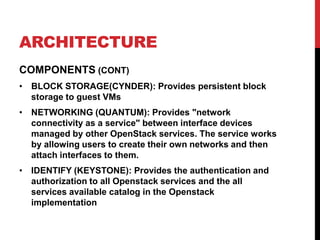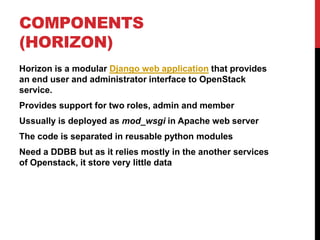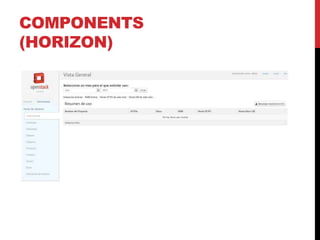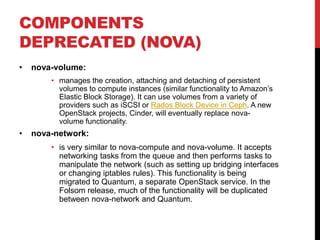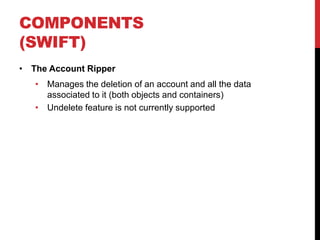Quick overview of Openstack architecture
- 2. OBJECTIVE To produce the ubiquitous Open Source cloud computing platform that will meet the needs of public and private cloud providers regardless of size, by being simple to implement and massively scalable.
- 3. WHAT’S OPENSTACK? Openstack is a Platform free and Libre Open Source of IaaS Cloud Computing
- 4. WHAT’S OPENSTACK? Openstack is a Platform free and Libre Open Source of IaaS Cloud Computing • Different components • Interrelated Components • Define component functions • Define what services offer
- 5. WHAT’S OPENSTACK? Openstack is a Platform free and Libre Open Source of IaaS Cloud Computing • Collaborative • Open Code / Modifiable (Multiple implementations) • Free Managed by the nonprofit OpenStack Foundation
- 6. WHAT’S OPENSTACK? Openstack is a Platform free and Libre Open Source of IaaS Cloud Computing • Infraestructure as a service • Storage, Computing, Networking
- 7. WHAT’S OPENSTACK? Openstack is a Platform free and Libre Open Source of IaaS Cloud Computing • Infraestructure as a service • Storage, Computing, Networking • Networks on demand • Storage on demand • Computing on demand • Security groups
- 8. HISTORY Started in July of 2010 by the NASA and Rackspace, evolved two existing projects • Nebula project of the NASA • Cloud Files project of Rackspace
- 9. HISTORY/VERSIONS Every six month has released a new version
- 11. ARCHITECTURE COMPONENTS • DASHBOARD (HORIZON) provides a modular web-based user interface for all the OpenStack services. With this web GUI, you can perform most operations on your cloud like launching an instance, assigning IP addresses and setting access controls • COMPUTE (NOVA): provides virtual servers upon demand, based in images • IMAGE (GLANCE): provides the images catalog (virtual disks), available for use by compute service • OBJECT STORAGE (SWIFT): Allows you to store or retrieve files (but not mount directories like a fileserver.
- 12. ARCHITECTURE COMPONENTS (CONT) • BLOCK STORAGE(CYNDER): Provides persistent block storage to guest VMs • NETWORKING (QUANTUM): Provides "network connectivity as a service" between interface devices managed by other OpenStack services. The service works by allowing users to create their own networks and then attach interfaces to them. • IDENTIFY (KEYSTONE): Provides the authentication and authorization to all Openstack services and the all services available catalog in the Openstack implementation
- 13. ARCHITECTURE
- 14. ARCHITECTURE
- 15. ARCHITECTURE
- 16. COMPONENTS (HORIZON) Horizon is a modular Django web application that provides an end user and administrator interface to OpenStack service. Provides support for two roles, admin and member Ussually is deployed as mod_wsgi in Apache web server The code is separated in reusable python modules Need a DDBB but as it relies mostly in the another services of Openstack, it store very little data
- 18. COMPONENTS (NOVA) Nova is the most complicated and distributed component of OpenStack. A large number of processes cooperate to turn end user API requests into running virtual nova-api - manages API calls nova-compute - manages hypervisor calls nova-scheduler - determines assigned host to a VM nova-volume and nova-network are replaced in folsom by cinder and quantum
- 19. COMPONENTS (NOVA) • nova-api: • Supports EC2 API, OpenStack Compute API and Admin API • Manages the API calls inside nova service • API frontend to OpenStack environment • It also initiates most of the orchestration activities (such as running an instance) as well as enforces some policy (mostly quota checks) • nova-compute: • Manages the VM execution on the different hypervisors supported by OpenStack (XenAPI for XenServer/XCP, libvirt for KVM or QEMU, VMwareAPI for VMware, etc) • Orchestrates image usage by VM's with Glance service through glance-api component • Manages networks to be used by VM's through the quantum server component
- 20. COMPONENTS (NOVA) • nova-schedule: • Determines in which physical host should run a given VM based on the resources required Nova interacts with many other OpenStack services: Keystone for authentication, Glance for images and Horizon for web interface. The Glance interactions are central. The API process can upload and query Glance while nova-compute will download images for use in launching images
- 21. ADDITIONAL COMPONENS (NOVA) • Queue: • provides a central hub for passing messages between daemons. This is usually implemented with RabbitMQ today, but could be any AMPQ message queue (such as Apache Qpid). New to the Folsom release is support for Zero MQ • SQL database: • stores most of the build-time and run-time state for a cloud infrastructure. This includes the instance types that are available for use, instances in use, networks available and projects. Theoretically, OpenStack Nova can support any database supported by SQL-Alchemy but the only databases currently being widely used are MySQL and PostgreSQL • nova-console, nova-vncproxy and nova-consoleauth: • Provides console services to allow end users to access their virtual instance's console through a proxy
- 22. COMPONENTS DEPRECATED (NOVA) • nova-volume: • manages the creation, attaching and detaching of persistent volumes to compute instances (similar functionality to Amazon’s Elastic Block Storage). It can use volumes from a variety of providers such as iSCSI or Rados Block Device in Ceph. A new OpenStack projects, Cinder, will eventually replace nova- volume functionality. • nova-network: • is very similar to nova-compute and nova-volume. It accepts networking tasks from the queue and then performs tasks to manipulate the network (such as setting up bridging interfaces or changing iptables rules). This functionality is being migrated to Quantum, a separate OpenStack service. In the Folsom release, much of the functionality will be duplicated between nova-network and Quantum.
- 23. COMPONENTS (NOVA) NOVA-CLI List availables image and flavors nova image-list nova flavor-list Create a keypair in order to access the VM nova keypair-add mykey > mykey.pem Launch a VM using images and flavors nova boot <MYMACHINE_NAME> --image "<IMAGE_ID>" –flavor <FLAVOR_ID> --key_name <MYKEY_NAME> --file /root/.ssh/authorized_keys=my_authorized_keys It's possible to resize a VM from a flavor to a different one nova resize <VM_ID> <NEW_FLAVOR_ID> And send data to the cloud-init executed on the VM nova resize-confirm / nova resize-revert
- 24. COMPONENTS (NOVA) NOVA-CLI Managing security groups. Check the default one nova secgroup-list Each security group has an associated rule set nova secgroup-list-rules default Adding new rules to our security group nova secgroup-add-rule default tcp 80 80 0.0.0.0/0 List floating ip’s in our pool nova floating-ip-pool-list Create new floating ip nova floating-ip-create nova Floating IP can be associated to a running VM nova add-floating-ip <VM_NAME> <FLOATINGIP_IP>
- 25. COMPONENTS (GLANCE) Provides a VM image catalog and repository services allowing the registration and retrieval of those. Provides a RESTful API that allows querying of VM image metadata as well as retrieval of the actual image Support the retrieval of the images from multiple storages (Filesystem based, Swift based, S3 based) Images supported (raw, vhd, vmdk, vdi, iso, qcow2, aki, ari and ami) Containers supported (ovf, aki, ari and ami) Creation image tools supported (Oz – KVM, VMBuilder - KVM, Xen, VeeWee – KVM) http://docs.openstack.org/trunk/openstackcompute/admin/content/ starting-images.html
- 26. COMPONENTS (GLANCE) • glance-api accepts Image API calls for image discovery, image retrieval and image storage • glance-registry stores, processes and retrieves metadata about images (size, type, etc) • A database to store the image metadata • A storage repository for the actual image files
- 27. COMPONENTS (SWIFT) Provides object storage services Fault-tolerance and highly scalable architecture Designed to run on commodity hardware Large object support (Object maximum size is 5GB) Considerations Swift Cluster • RAID not good for disk backend • Proxy servers are I/O and CPU intensive • Object, container and account services more I/O and disk intensive
- 29. COMPONENTS (SWIFT) • Proxy server • Manages the swift service infrastructure • Look for the account, container and object, and route to the appropriate resource • Manages the swift API • Provides fault-tolerance architecture for object servers providing alternatives to failing hosts • The ring • Maps the logical name of a resource stored in swift to its physical location • Separate rings for accounts, containers and objects • Manages how many times a partition is replication along the swift cluster (3 by default, on different zones)
- 30. COMPONENTS (SWIFT) • Object server • Blob storage server • Objects stored as binary files + xattrs (FS supported) • Replicas of the objects across the cluster are consistent with the last write (if removed .ts) • Object server - xattrs • Extended attributes of a file provided by the filesystem • XFS recommended by Rackspace • Container server • Manages the object-container relationship and some stats about it • Knows what objects are associated to a given container and its total size • Its backend is replicated along the cluster (default sqlite)
- 31. COMPONENTS (SWIFT) • Consistency servers · Replication • Manages replication for objects, containers and accounts • Capable to handle hw outages (disk failure, network outage) • rsync for object, HTTP/rsync db for containers and accounts • Objects stored as binary files + xattrs (FS supported) • Replicas of the objects across the cluster are consistent with the last write (if removed .ts) • Consistency servers · Updaters • Manages the update process under high load behaviours on the swift cluster • Consistency window • Consistency servers · Auditors • Check the integrity of objects, containers and accounts • Reload from replicas those which are not consistent
- 32. COMPONENTS (SWIFT) • The Account Ripper • Manages the deletion of an account and all the data associated to it (both objects and containers) • Undelete feature is not currently supported
- 33. COMPONENTS (CINDER) Provides block storage to VM's managed by Nova Supports new third party storage drivers Ability to create image from volume Support for NFS as block storage Storage backend support for(Netapp,EMC,IBM) • A storage driver for Cinder is provided • Allows to connect directly the storage with the hypervisor
- 34. COMPONENTS (CINDER) • cinder-volume • Manages the volume creation and the interaccion with the backend storage • cinder-api • Manages the calls to the Cinder API • cinder-scheduler • Manages the volume location
- 35. COMPONENTS (QUANTUM) Provides network services to VM's running in Nova Several backends plugins (OVS, LinuxBridge, ...) Floating IP's (NAT) Considerations • Very intensive CPU use • Very high networking load
- 37. COMPONENTS (QUANTUM) • quantum-server • Manages the Quantum service API calls • Orchestrates the provisioning of virtual network elements (networks, subnets, routers, ...) for its use with VM's provided by Nova • quantum-agents • L3 agent: Manages the provisioning of network connectivity to external networks, including floating IP pools associated to those • DHCP agent: Allocates IP address for the VM's on a given network/subnet
- 38. COMPONENTS (QUANTUM) • quantum-plugins • Provides an interface between the logical view and the physical way (different implementations) • The following plugins are currently supported (Open vSwitch, Cisco UCS/Nexus, Linux Bridge, Nicira NVP, Ryu, NEC, OpenFlow, Big Switch - Floodlight REST Proxy)
- 39. COMPONENTS (QUANTUM) • quantum-plugins • Provides an interface between the logical view and the physical way (different implementations) • The following plugins are currently supported (Open vSwitch, Cisco UCS/Nexus, Linux Bridge, Nicira NVP, Ryu, NEC, OpenFlow, Big Switch - Floodlight REST Proxy)
- 40. COMPONENTS (KEYSTONE) The OpenStack identity service Provides the following services: identity, token, catalog and policy Used by all services of the OpenStack family Accessible through the Identity API Supported keystone backends(Default sqlite): Key Value Store (KVS), SQL, PAM, LDAP(just identity)
- 41. COMPONENTS (KEYSTONE) SERVICES • Catalog: Provides a directory service for the endpoints of the OpenStack services • Policy: Provides access to resources to users based on the permissions these users have on those • Identity: Provides auth validation for users, tenants and roles • Token: Manages all the token auth process, once the user/tenant credentials have been verified
- 43. COMPONENTS (KEYSTONE) Endpoints Keystone is not just about auth, but also a directory service Each OpenStack service has an endpoint associated(REST API) The Keystone directory service provides the URL of the end points of the different OpenStack services
- 44. HA GLANCE • glance-api - (Pacemaker + Corosync) • glance-registry
- 45. HA NOVA Configure different instances of Nova • Networking – use nova-network (configure all network connections in all Nova nodes) CINDER • quantum-server (API) – (Pacemaker + Corosync) • l3-agent - one per external network (active/passive) • dhcp-agent + ovs - (active/passive)
- 46. HA Font-end API servers • load balanced with h/w load balancer • use s/w LB for smaller deployments • run nova-scheduler on each MySQL DB • multi-master configuration • alternative: drbd + pacemaker in active/passive
- 47. HA RabbitMQ service • Pacemaker with Active-passive configuration • Virtual IP for the service - used for rabbitmq config in nova.conf Glance • Run on multiple servers • Use another VIP in your pacemaker setup or load-balancer • Use swift as backend storage
- 48. HA Compute servers • Each run their own copy of nova-api (only instances running on the node use this) • nova-network (multi-host configuration) with private network Swift • Run swift-proxy across all swift-storage nodes on a small setup
- 49. HA Storage block Volumen with Pacemaker + iSCSI target • CEPH / GlusterFS (Work in Progress) QUANTUM • quantum-server (API) – (Pacemaker + Corosync) • l3-agent - one per external network (active/passive) • dhcp-agent + ovs - (active/passive)
- 50. HA Keystone • Run on multiple servers • Use another VIP in your pacemaker setup or load-balancer Horizon • Run on multiple servers • Use another VIP in your pacemaker setup or load-balancer












